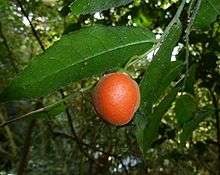Drypetes arguta
Drypetes arguta, commonly known as the water ironplum,[2] is a species of small tree or large bush in the family Putranjivaceae. It is native to tropical East Africa. It was first described in 1920 by the English botanist John Hutchinson, who named it Cyclostemon argutus. It was later transferred to the genus Drypetes.[3]
| Drypetes arguta | |
|---|---|
 | |
| Water ironplum fruit in Krantzkloof Nature Reserve in KwaZulu-Natal. | |
| Scientific classification | |
| Kingdom: | Plantae |
| Clade: | Tracheophytes |
| Clade: | Angiosperms |
| Clade: | Eudicots |
| Clade: | Rosids |
| Order: | Malpighiales |
| Family: | Putranjivaceae |
| Genus: | Drypetes |
| Species: | D. arguta |
| Binomial name | |
| Drypetes arguta | |
| Synonyms | |
| |
Description
Drypetes arguta is a small tree or large straggling shrub, growing to a height of about 8 m (26 ft).[4] The bark is grey, either smooth or with fine vertical furrows.[5] The leaves have short stalks and a pair of yellow linear stipules at the base, and are arranged alternately on slender, greyish twigs. They are bright green, up to 11 cm (4.3 in) long, elliptical to lanceolate, with uneven bases and attenuated tips. There are glands at the tips of the marginal teeth. The flowers grow in clusters or singly in the axils of the leaves. They are unisexual, with male flowers being on a different tree from female flowers. They are yellowish-green and fragrant, and are followed by globular, fleshy fruit up to 2 cm (0.8 in) in diameter which turn orangish-red as they ripen.[2]
Distribution and habitat
Drypetes arguta is native to eastern Africa where its range extends from Tanzania and Zimbabwe, southwards to Mozambique, Swaziland, and South Africa (KwaZulu-Natal and the Eastern Cape). It grows in forests and alongside water-courses, at altitudes of up to 600 m (2,000 ft).[2] It is also a major constituent of the flora of the Southern African Sand Forest, a habitat consisting of woodland growing on ancient sand dunes located on the border between southern Mozambique and northern KwaZulu-Natal.[6]
Uses
Sections of branches of this tree have traditionally been used in hut construction, and the wood has also been used to make sticks. The fruits are edible and have been used to make a fermented alcoholic drink.[4]
References
| Wikimedia Commons has media related to Drypetes arguta. |
- "Drypetes arguta (Müll.Arg.) Hutch". The Plant List. Retrieved 27 July 2019.
- Hyde, M.A.; Wursten, B.T.; Ballings, P.; Coates Palgrave, M. "Drypetes arguta (Müll.Arg.) Hutch". Flora of Zimbabwe. Retrieved 27 July 2019.CS1 maint: multiple names: authors list (link)
- "Drypetes arguta (Müll. Arg.) Hutch". Tropicos. Missouri Botanical Garden. Retrieved 27 July 2019.
- Lemmens, R.H.M.J.; Louppe, D.; Oteng-Amoako, A.A. Timbers 2. PROTA. p. 320. ISBN 978-92-9081-495-5.CS1 maint: multiple names: authors list (link)
- Palgrave, Keith Coates (2015). Palgrave's Trees of Southern Africa. Penguin Random House South Africa. p. 2519. ISBN 978-1-920572-74-7.
- Matthews, Wayne. "Maputaland's Tembe Elephant National Park – a little known reserve with many natural secrets". Retrieved 27 July 2019.